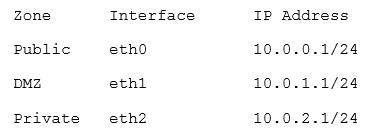Which of the following network design elements allows for many internal devices to share one public IP address?
A. DNAT
B. PAT
C. DNS
D. DMZ
CompTIA exam questions
Which of the following network design elements allows for many internal devices to share one public IP address?
A. DNAT
B. PAT
C. DNS
D. DMZ
A network administrator receives a call asking for assistance with connecting to the network. The user asks for the IP address, subnet class, and VLAN required to access the network. This describes which of the following attacks?
A. Social engineering
B. Spoofing
C. Zero-day attack
D. VLAN hopping
A technician needs to set aside addresses in a DHCP pool so that certain servers always receive the same address. Which of the following should be configured?
A. Leases
B. Helper addresses
C. Scopes
D. Reservations
Jane, a network technician is preparing to configure a company’s network. She has installed a firewall to allow for an internal DMZ and external network. No hosts on the internal network should be directly accessible by IP address from the internet, but they should be able to communicate with remote networks after receiving a proper IP address. Which of the following is an addressing scheme that will work in this situation?
A. Teredo tunneling
B. Private
C. APIPA
D. Classless
Upon arrival at work, an administrator is informed that network users cannot access the file server. The administrator logs onto the server and sees the updates were automatically installed and the network connection shows limited and no availability. Which of the following needs to be rolled back?
A. The browser on the server
B. The server’s NIC drivers
C. The server’s IP address
D. The antivirus updates
A PC technician has installed a new network printer that was preconfigured with the correct static IP address, subnet mask, and default gateway. The printer was installed with a new cable and appears to have link activity, but the printer will not respond to any network communication attempts. Which of the following is MOST likely the cause of the problem?
A. Damaged cable
B. Duplex mismatch
C. Incorrect VLAN assignment
D. Speed mismatch
While troubleshooting a connectivity issue, a network technician determines the IP address of a number of workstations is 169.254.0.0/16 and the workstations cannot access the Internet. Which of the following should the technician check to resolve the problem?
A. Default gateway address
B. Misconfigured DNS
C. DHCP server
D. NIC failure
A network technician needs to separate a web server listening on port 80 from the internal LAN and secure the server from the public Internet. The web server should be accessible to the public Internet over port 80 but not the private LAN. Currently, the network is segmented with a network-based firewall using the following IP addressing scheme on each interface:

Which of the following ones should the technician use to place the web server and which of the following firewall rules should the technician configure?
A. Place the web server in the public zone with an inbound rule from eth0 interface to accept traffic over port 80 designated to the web server
B. Place the web server in the DMZ with an inbound rule from eth0 interface to eth1 to accept traffic over port 80 designated to the web server
C. Place the web server in the private zone with an inbound rule from eth2 interface to eth1 to accept traffic over port 80 designated to the web server
D. Place the web server in the DMZ with an inbound rule from eth1 interface to eth0 to accept traffic over port 80 designated to the web server